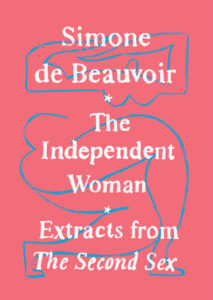
Simone de Beauvoir: "How Many Bland and Dull Escapist Novels There Are!"
The Author of The Second Sex... Calling It Like She Sees It
Today the expressive arts are not the only ones open to women: many try their hand at creative activities.
Woman’s situation encourages her to seek salvation in literature and in art. Living on the margin of the masculine world, she does not grasp it in its universal guise but through a particular vision; for her it is not a group of implements and concepts but a source of feelings and emotions; she is interested in the qualities of things inasmuch as they are gratuitous and secret; taking on a negative attitude, one of refusal, she does not lose herself in the real: she protests against it, with words; she looks for the image of her soul in nature, she abandons herself to her reveries, she wants to reach her being: she is doomed to failure; she can only recover it in the realm of imagination. So as not to allow an inner life that does not serve any purpose to sink into nothingness, so as to assert herself against the given that she endures in revolt, so as to create a world other than the one in which she cannot succeed in reaching herself, she needs to express herself. Thus it is well-known that she is talkative and a scribbler; she pours out her feelings in conversations, letters and diaries. If she is at all ambitious, she will be writing her memoirs, transposing her biography into a novel, breathing her feelings into poems. She enjoys vast leisure time that favors these activities.
But the very circumstances that orient the woman toward creation also constitute obstacles she will often be unable to overcome. When she decides to paint or write just to fill the emptiness of her days, paintings and essays will be treated as “ladies’ work”; she will devote little time or care to them and they will be worth about as much. To compensate for the flaws in her existence, often the woman at menopause feverishly takes up the brush or pen: it is late; without serious training, she will never be more than an amateur. But even if she begins quite young, she rarely envisages art as serious work; used to idleness, never having experienced in her life the austere necessity of a discipline, she will not be capable of a steady and persevering effort, she will not compel herself to acquire a solid technique; she balks at the thankless and solitary trials and errors of work that is never exhibited, that has to be destroyed and done over again a hundred times; and as from childhood she was taught to cheat in order to please, she hopes to get by with a few ruses. This is what Marie Bashkirtseff admits. “Yes, I don’t take the trouble to paint. I watched myself today, I cheat.”
The woman easily plays at working but she does not work; believing in the magic virtues of passivity, she confuses conjurations and acts, symbolic gestures and effective behavior; she disguises herself as a Beaux-Arts student, she arms herself with her arsenal of brushes; planted in front of her easel, her gaze wanders from the blank canvas to her mirror; but the bouquet of flowers, the bowl of apples, do not appear on their own on the canvas. Seated at her desk, musing over vague stories, the woman acquires a peaceful alibi in imagining she is a writer: but she must at some point make signs on the blank page; they have to have a meaning in the eyes of others. So the trickery is exposed. To please one needs only to create mirages: but a work of art is not a mirage, it is a solid object; to construct it, one must know one’s craft. It is not only thanks to her gifts or personality that Colette became a great writer; her pen was often her livelihood and she demanded of it the careful work that a good artisan demands of his tool; from Claudine to Break of Day, the amateur became professional: the progress brilliantly shows the advantages of a strict apprenticeship. Most women, though, do not understand the problems that their desire for communication poses: and this is what largely explains their laziness. They have always considered themselves as givens; they believe their worth comes from an inner grace and they do not imagine that value can be acquired; to seduce, they know only how to display themselves: their charm works or does not work, they have no grasp on its success or failure; they suppose that, in a similar way, to express oneself, one needs only show what one is; instead of constituting their work by a thoughtful effort, they put their confidence in spontaneity; writing or smiling is all one to them: they try their luck, success will come or will not.
Sure of themselves, they reckon that the book or painting will be successful without effort; timid, they are discouraged by the least criticism; they do not know that error can open the road to progress, they take it for an irreparable catastrophe, like a malformation. This is why they often overreact, which is harmful to themselves: they become irritated and discouraged when recognizing their errors rather than drawing valuable lessons from them. Unfortunately, spontaneity is not as simple as it appears: the paradox, of the commonplace—as Paulhan explains in The Flowers of Tarbes—is that it is nothing more than the immediate translation of the subjective impression. Thus, when the woman produces the image she creates without taking others into account, she thinks she is most unusual, but she is merely reinventing a banal cliché; if she is told, she is surprised and vexed and throws down her pen; she is not aware that the public reads with its own eyes and its own mind and that a brand-new epithet can awaken in it many old memories; of course, it is a precious gift to be able to dig down into oneself and bring up vibrant impressions to the surface of language; one admires Colette for a spontaneity not found in any male writer; but—although these two terms seem to contradict each other—hers is a thoughtful spontaneity: she refuses some of its contributions and accepts others as she sees fit; the amateur, rather than seizing words as an inter-individual relation, an appeal to the other, sees in them the direct revelation of her feelings; editing or crossing out for her means repudiating a part of self; she does not want to sacrifice anything both because she delights in what she is and because she hopes not to become other. Her sterile vanity comes from the fact that she cherishes herself without daring to construct herself.
It is natural for women to try to escape this world where they often feel unrecognized and misunderstood.
Thus, very few of the legions of women who attempt to dabble in literature and art persevere; those who overcome this first obstacle very often remain divided between their narcissism and an inferiority complex. Not being able to forget oneself is a failure that will weigh on them more heavily than in any other career; if their essential goal is an abstract self-affirmation, the formal satisfaction of success, they will not abandon themselves to the contemplation of the world: they will be incapable of creating it anew. Marie Bashkirtseff decided to paint because she wanted to become famous; the obsession with glory comes between her and reality; she does not really like to paint: art is merely a means; it is not her ambitious and empty dreams that will reveal to her the meaning of a color or face. Instead of giving herself generously to the work she undertakes, the woman all too often considers it a simple ornament of her life; books and paintings are only an inessential intermediary allowing her to exhibit this essential reality publicly: her own person. Thus it is her person that is the main—sometimes only—subject that interests her: Mme Vigée-Lebrun does not tire of putting her smiling maternity on her canvases.
Even if she speaks of general themes, the woman writer will still speak of herself: one cannot read such and such theater reviews without being informed of the size and corpulence of their author, the color of her hair and the peculiarities of her personality. Of course, the self is not always detestable. Few books are as fascinating as certain confessions: but they have to be sincere and the author has to have something to confess. Instead of enriching the woman, her narcissism impoverishes her; involved in nothing but self-contemplation, she eliminates herself; even the love she bestows on herself becomes stereotyped: she does not discover in her writings her authentic experience but an imaginary idol constructed from clichés. She cannot be criticized for projecting herself in her novels as Benjamin Constant and Stendhal did: but unfortunately she sees her story too often as a silly fairy tale; the young girl hides the brutal and frightening reality from herself with good doses of fantasizing: it is a pity that once she is an adult, she still buries the world, its characters, and herself in the fogginess of poetry. When the truth emerges from this travesty, there are sometimes charming successes, but next to Dusty Answer or The Constant Nymph, how many bland and dull escapist novels there are!
It is natural for women to try to escape this world where they often feel unrecognized and misunderstood; what is regrettable is that they do not dare the bold flights of a Gérard de Nerval or a Poe. Many reasons excuse woman’s timidity. Her great concern is to please; and as a woman she is often already afraid of displeasing just because she writes: the term “blue-stocking,” albeit a bit overused, still has a disagreeable connotation; she lacks the courage to displease even more as a writer. The writer who is original, as long as he is not dead, is always scandalous; what is new disturbs and antagonizes; women are still astonished and flattered to be accepted into the world of thinking and art, a masculine world: the woman watches her manners; she does not dare to irritate, explore, explode; she thinks she has to excuse her literary pretensions by her modesty and good taste; she relies on the proven values of conformism; she introduces just the personal note that is expected of her into her literature: she points out that she is a woman with some well-chosen affectations, simpering and preciosities; so she will excel at producing “bestsellers” but she cannot be counted on to blaze new trails.
Women do not lack originality in their behavior and feelings: there are some so singular that they have to be locked up; on the whole, many of them are more baroque and eccentric than the men whose strictures they reject. But they put their bizarre genius into their lives, conversation and correspondence; if they try to write, they feel crushed by the universe of culture because it is a universe of men: they just babble. Inversely, the woman who chooses to reason, to express herself using masculine techniques, will do her best to stifle an originality she distrusts; like a female student, she will be assiduous and pedantic; she will imitate rigor and virile vigor. She may become an excellent theoretician and acquire a solid talent; but she will make herself repudiate everything in her that is “different.” There are women who are mad and there are women of talent: none of them has this madness in talent called genius.
_____________________________________

From THE INDEPENDENT WOMAN: Extracts from The Second Sex. Copyright © 1949 by Editions Gallimard, Paris. Translation copyright © 2009 by Constance Borde and Sheila Malovany-Chevallier. Published by arrangement with Vintage Anchor Publishing, an imprint of The Knopf Doubleday Publishing Group, a division of Penguin Random House, LLC
Simone de Beauvoir
Simone de Beauvoir was born in Paris in 1908. In 1929 she became the youngest person ever to obtain the agrégation in philosophy at the Sorbonne. After the war, she emerged as one of the leaders of the existentialist movement, working with Jean-Paul Sartre on Les Temps Modernes. The Second Sex, first published in 1949, has been translated into forty languages and become a landmark in the history of feminism. Beauvoir was the author of many other books, including the novel The Mandarins, which was awarded the Prix Goncourt. She died in 1986.



















